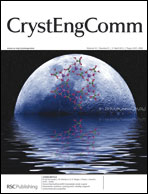By modulating the synthetic strategy based on changing the cosolvent in the synthesis, the aqueous medium assembly of lead(II) with H2ATBIP in the presence of different cosolvents, N,N-dimethylacetamide (DMA), methanol (CH3OH) or N,N-dimethylformamide (DMF), leads to a family of three lead(II) coordination polymers: [Pb(ATBIP)(H2O)2]·2H2O (1), [Pb(ATBIP)(H2O)(CH3OH)]·H2O (2) and [Pb(ATBIP)(H2O)(DMF)]·H2O (3) [H2ATBIP = 5-amino-2,4,6-tribromoisophthalic acid]. Complex 1 exhibits an interesting double chain structure with [Pb2(OH2)2] as the secondary building unit (SBU), which further assembles into a 3D supramolecular framework through the C–Br⋯Br halogen bonds and hydrogen bonds. Furthermore, the discrete water octamer (H2O)8 is found. The cosolvents, DMF and CH3OH, which simultaneously act as the coordinated small molecules, have significant influences on the formation of different crystalline architectures. Complex 2 features a 2D network constructed by the 21 helical carboxylate-bridged Pb(II) chains [Pb2(COO)2]n (SBUs) linked by the ligand ATBIP2−. The intralayer C–Br⋯Br halogen bond is found and a 3D supramolecular framework is formed by the interlayer hydrogen bonds. Complex 3 crystallizes in the chiral space group P41212 and possesses a 2D (4,4)-homochiral layer built from the centrosymmetrical SBU [Pb2(COO)2] bridged by the ligand ATBIP2−. The interlayer hydrogen bonds further extend the chiral layers in 3 into a 3D supramolecular homochiral framework. The coordination modes of the ligand ATBIP2− are greatly dependent on the cosolvents. Complex 3 loses crystallinity in the air and forms the material [Pb(ATBIP)(DMF)] (3A). Thermal stability and solid state fluorescent properties of 1, 2 and 3A have been studied. The second harmonic generation (SHG) property of 3A is also studied.


 Please wait while we load your content...
Please wait while we load your content...